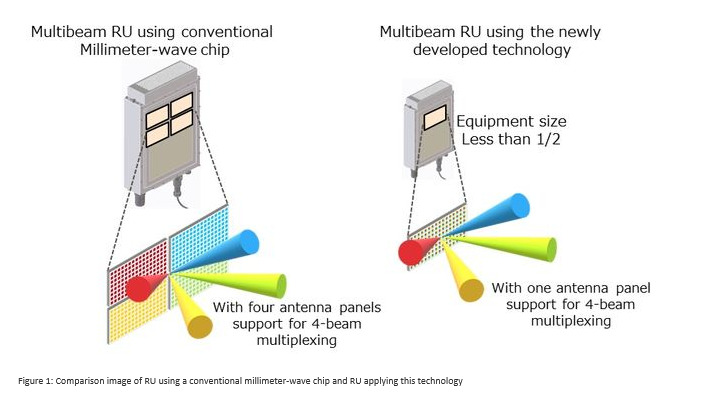Fujitsu develops millimetre-wave chip for 5G radio units
Fujitsu has announced the development of a new millimetre-wave chip for 5G that supports multibeam multiplexing (excluding polarisation multiplexing (1)), enabling up to four beams to be multiplexed by a single millimetre-wave chip for the radio units (RU) of 5G base stations.
The development was undertaken as part of the ‘Research and Development Project of the Enhanced Infrastructures for Post-5G (2) Information and Communication Systems’ (3) commissioned by Japan's New Energy and Industrial Technology Development Organization (NEDO).
With conventional technologies, a single millimetre-wave chip is used to generate a single beam, resulting in larger RUs and increased power consumption. When the newly developed technology is applied to actual base stations, Fujitsu demonstrated that it is possible to achieve high speed and capacity communications of 10Gbps or more with a half the size of a conventional RU. This allows for systems with fewer millimetre-wave chips, which ultimately leads to reductions in power consumption per RU by 30%. Project background 5G network technologies are expected to achieve higher speeds and capacity by effectively utilising wireless resources in the millimetre-wave band. While this approach offers the potential to significantly improve communications speed and capacity, millimetre and other high-frequency radio waves tend to be blocked by obstacles, making it difficult to communicate between great distances.
One possible approach to resolving this challenge includes covering one area with a larger number of radio base stations, which would help address issues such as the need to miniaturise RUs, energy savings, and cost reductions.
To address these challenges, from June 2020 to June 2023, Fujitsu worked to develop technologies that enhance the performance of RU under a project initiated by NEDO, which can be used in information and communications systems that support 5G. Fujitsu's research resulted in the development of a technology that enables multiple beam multiplexing on a single chip through millimetre-wave beamforming (4), making it possible to deliver four times the speed and larger capacity than a conventional RU of the same size to deliver significant energy and cost reductions. Future plans Kicking off development of base station hardware equipped with this technology from August 2023, Fujitsu aims to begin commercial deployment of RUs using the technology globally in fiscal 2024, and contribute to the spread of millimetre-wave in the global market and decarbonisation of the telecommunications industry. Subsequently, the beam multiplexing technology will be applied to base station (CU/DU) products, and will be offered globally in fiscal 2025.
In addition to contributing to the reduction of the carbon footprint of telecommunications carriers and other commercial users, Fujitsu will continue to develop technologies to advance the network industry and contribute to the rapid deployment of next-generation communications infrastructure.
(1) Polarisation Multiplex:
A technique for multiplexing and transmitting data using radio waves with different polarisations (the direction of vibration of an electric field), such as horizontally polarised waves and vertically polarised waves.
(2) Post-5G:
It is the 5th generation mobile communication system (5G) enhanced the feature of ultra-low latency and multiple simultaneous connections.
(3) Project:
Project name (JPNP20017): Research and Development Project of the Enhanced Infrastructures for Post-5G Information and Communication Systems (commissioned by the New Energy and Industrial Technology Development Organization (NEDO).
(4) Beamforming:
A technology that concentrates radio waves in a specific direction by controlling the phase (angle) of signals emitted by antenna elements on antenna panels.






